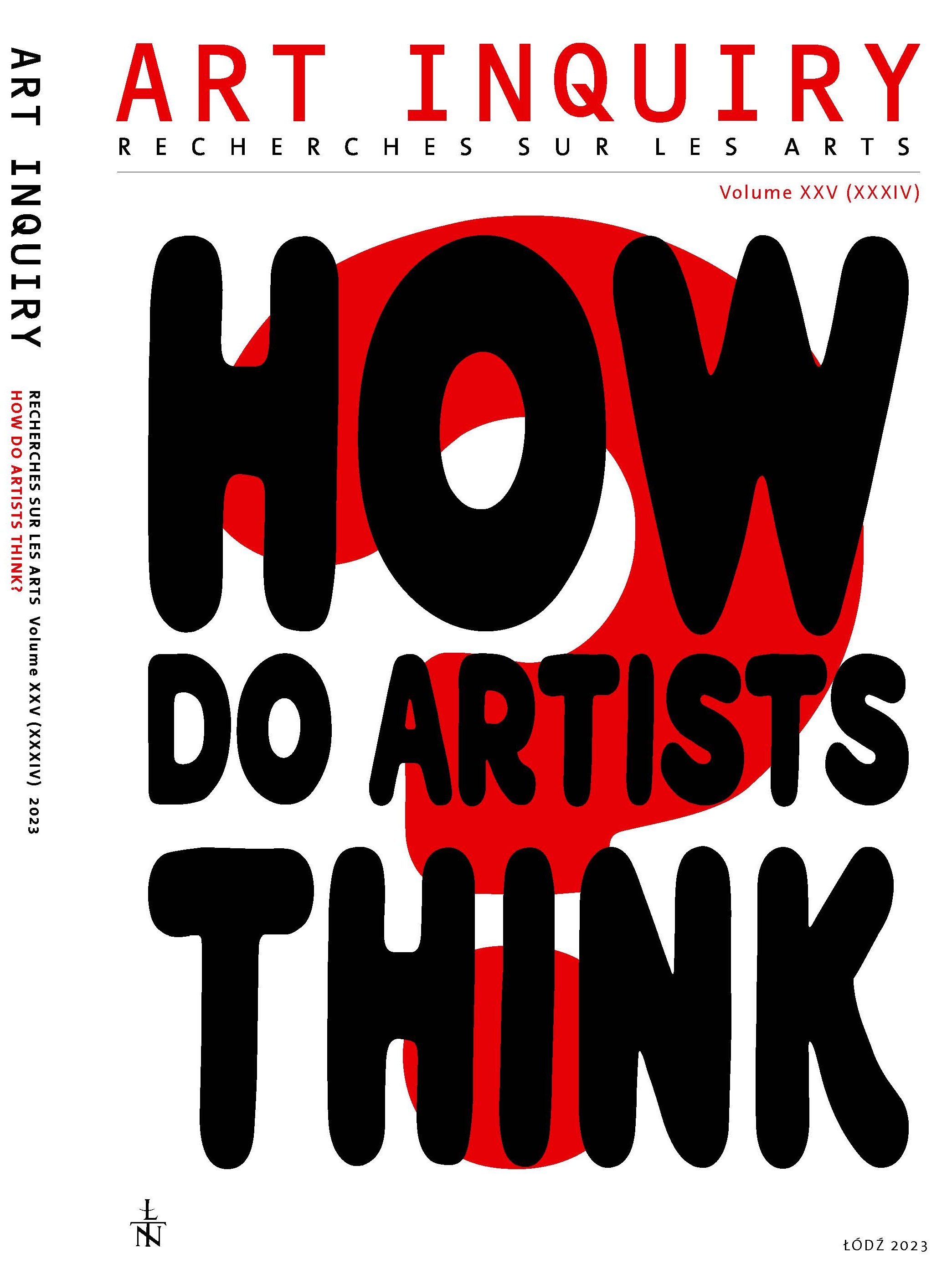Exhibition of works by Grzegorz Sztabiński at The University of Łódź, entitled hommage à Grzegorz Sztabiński – "continued...", as a contribution to the analysis of ways of looking at a work of art
DOI:
https://doi.org/10.26485/AI/2023/25/13Keywords:
Grzegorz Sztabiński, exhibition, modern art, eye tracking, experimentationAbstract
The article addresses the issue of confronting theoretical thought in the field of aesthetics with the results of apparatus measurements. The exhibition of works by the painter and installation artist Professor Grzegorz Sztabiński (1946-2020), presented in Łódź from 20.05.2022 to 20.07.2022 at Wozownia Gallery, became a pretext for conducting an experimental study related to the distribution of visual attention of its audience. Two people were surveyed: a layperson in the field of visual arts and an expert art historian. The intimate exhibition seen through their eyes provides a pretext for comparing theoretical complexities associated with the reception of a work of art (by such thinkers and philosophers as Aristotle, Hannah Arendt, Rudolf Arnheim or Władysław Strzemiński) with the results of objective analyses obtained using portable eye-tracking devices – Pupil Labs Invisible.
References
Arendt Hannah (1989) Thinking, Judging, Freedom, ed. Gisela T. Kaplan, Clive Kessler, Sydney: Allen & Unwin.
Aristotle, De Anima; 431a, 431, quote from: http://psychclassics.yorku.ca/Aristotle/De-anima/de-anima3.htm, [accessed: 30.06.2023].
Arnheim Rudolf (1974) Art and visual perception. A Psychology of the Creative Eye. New version, University of California Press: Berkeley, Los Angeles, London.
Buber Martin (1993) Problem człowieka, transl. J. Doktór. Wydawnictwo Naukowe PWN: Warszawa.
Czekalski Stanisław (2012) Dzieło w perspektywie odbiorczej: między historią sztuki, kulturą wizualną i egzystencjalną hermeneutyką, in: Co z tym odbiorcą? Wokół zagadnienia odbioru sztuki, ed. J. Ryczek, M. Kędziora, W. Nowak, Wydawnictwo Naukowe Wydziału Nauk Społecznych UAM: Poznań, pp. 27-34.
Dziemidok Bohdan (2002), Główne kontrowersje współczesnej estetyki, Wydawnictwo Naukowe PWN: Warszawa.
Eghbal-Azar Kira (2016) Affordances, appropriation and experience in museum exhibitions: Visitors' (eye) movement patterns and the influence of digital guides [PhD thesis], Universität zu Keoln, https://kups.ub.uni-koeln.de/7606/ [30.06.2023].
Eco Umberto (1989) The Open Work, transl. A. Cancogni, Harvard University Press, Cambridge, Massachusetts.
Francuz Piotr (2015) Imagia. W kierunku neurokognitywnej teorii obrazu. Wydawnictwo Kul: Lublin.
Garbutt Michael, et al. (2020) The Embodied Gaze: Exploring Applications for Mobile Eye Tracking in the Art Museum, "Visitor Studies", 23, pp. 82-100.
Garbutt Michael, Nico Roenpagel (2018) Developing a Mindful Eye, in: Garbutt M., Roenpagel N. (ed.), The mindful eye: Contemplative pedagogies in visual arts education, Common Ground Research Networks, Champaign IL, USA.
Gołaszewska Maria (1984), Zarys estetyki. Problematyka, metody, teorie, Wydawnictwo Naukowe PWN: Warszawa.
Gregory Richard L. (1998) Eye and Brain: The Psychology of Seeing, Oxford: Oxford University Press.
Helmholtz Hermann (1866) Treatise of Physiological Optics, Vol. III, 3rd edition, New York, NY: Dover.
Imdahl Max (1990) Giotto: z zagadnień ikonicznej struktury sensu, transl. Tadeusz Żuchowski, "Artium Quaestiones", vol. 4, pp. 103-122.
Ingarden Roman (1966) Przeżycie. Dzieło. Wartość, Wydawnictwo Literackie: Kraków.
Jedlińska Eleonora, Piotr Gryglewski (2021) Grzegorz Sztabiński (1946-2020), "Przegląd Nauk Historycznych" R. XX, no. 1, pp. 383-387.
Juszkiewicz Piotr (2018) Regeneracja oka, regeneracja obrazu. Widzenie jako jedna z kluczowych kategorii modernizmu, in: Widzenie awangardy, ed. Agata Stankowska, Marcin Telicki, Agata Lewandowska, Wydawnictwo Poznańskiego Towarzystwa Przyjaciół Nauk, Poznań, pp. 23-34.
Kędziora Monika, Witold Nowak, Justyna Ryczek (2012) Co z tym odbiorcą. Wokół zagadnienia odbioru sztuki, Repozytorium Uniwersytetu im. Adama Mickiewicza: Poznań.
Krejtz Izabela, Krzysztof Krejtz, Max Bielecki (2008) Zastosowania analizy ruchu oczu w badaniach społecznych, "Psychologia Społeczna", vol. 3, 1(6), pp. 73-86.
Krejtz Krzysztof, Szczeciński Patryk, Aneta Pawłowska, Daria Rutkowska-Siuda, Katarzyna Wisiecka, Piotr Milczarski, Artur Hłobaż, A. T. Duchowski, Izabel Krejtz (2023) A Unified Look at Cultural Heritage: Comparison of Aggregated Scanpaths over Architectural Artifacts Between Exp Non-Experts, "Symposium on Eye Tracking Research & Applications" (May), Tübingen, Germany. ACM, New York, NY, USA.
Lapointe Sandra (2018) Introduction to Volume 5. Philosophy of Mind in the Nineteenth Century: The History of the Philosophy of Mind, Vol. 5, pp. 1-22.
Młodkowski Jan (2008) Koncepcja uwagi wizualnej, "Acta Universitatis Lodziensis, Folia Psychologica", 12, pp. 23-25.
Ober Jan, Jacek Dylak, Wojciech Gryncewicz, Elżbieta Przedpelska-Ober (2009) Sakkadometria – nowe możliwości oceny stanu czynnościowego ośrodkowego układu nerwowego, "Nauka" 4, pp. 109-135.
Quiroga Rodrigo Quian, Carlos Pedreira (2011) How do we see art: an eye-tracker study, "Frontiers in Human Neuroscience. Cognitive Neuroscience", vol. 5, https://doi.org/10.3389/fnhum.2011.0009 [accessed: 30.06.2023].
Rayner Keith (1998) Eye Movements in Reading and Information Processing: 20 Years of Research, "Psychological Bulletin", 124(3), pp. 372–422.
Schlag John, Medeleine Schlag-Rey (2002) Through the eye, slowly; Delays and localization errors in the visual system. Nature Reviews Neuroscience 3, p. 191. https://doi.org/10.1038/nrn750, [accessed: 30.06.2023].
Stolińska Anna, Magdalena Andrzejewska (2017), Metodologiczne aspekty stosowania techniki eye trackingowej w badaniach edukacyjnych, "Przegląd Badań Edukacyjnych / Educational Studies Review", no. 24 (1), pp. 259–276.
Strzemiński Władysław (1958) Teoria widzenia, 1st edition, https://monoskop.org/images/3/38/Strzeminski_Wladyslaw_Teoria_widzenia.pdf, [accessed: 30.06.2023].
Sztabiński Grzegorz (2010) Grzegorz Sztabiński – tautologii i powtórzenia, Galeria Wozownia: Toruń.
Sztabiński Grzegorz (2020) Inne pojęcia estetyki, Wydawnictwo Universitas: Kraków.
Downloads
Published
Issue
Section
License

This work is licensed under a Creative Commons Attribution-NonCommercial-NoDerivatives 4.0 International License.



